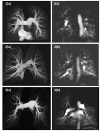Quantitative magnetic resonance imaging of pulmonary hypertension: a practical approach to the current state of the art
- PMID: 24552882
- PMCID: PMC4015452
- DOI: 10.1097/RTI.0000000000000079
Quantitative magnetic resonance imaging of pulmonary hypertension: a practical approach to the current state of the art
Abstract
Pulmonary hypertension is a condition of varied etiology, commonly associated with poor clinical outcome. Patients are categorized on the basis of pathophysiological, clinical, radiologic, and therapeutic similarities. Pulmonary arterial hypertension (PAH) is often diagnosed late in its disease course, with outcome dependent on etiology, disease severity, and response to treatment. Recent advances in quantitative magnetic resonance imaging (MRI) allow for better initial characterization and measurement of the morphologic and flow-related changes that accompany the response of the heart-lung axis to prolonged elevation of pulmonary arterial pressure and resistance and provide a reproducible, comprehensive, and noninvasive means of assessing the course of the disease and response to treatment. Typical features of PAH occur primarily as a result of increased pulmonary vascular resistance and the resultant increased right ventricular (RV) afterload. Several MRI-derived diagnostic markers have emerged, such as ventricular mass index, interventricular septal configuration, and average pulmonary artery velocity, with diagnostic accuracy similar to that of Doppler echocardiography. Furthermore, prognostic markers have been identified with independent predictive value for identification of treatment failure. Such markers include large RV end-diastolic volume index, low left ventricular end-diastolic volume index, low RV ejection fraction, and relative area change of the pulmonary trunk. MRI is ideally suited for longitudinal follow-up of patients with PAH because of its noninvasive nature and high reproducibility and is advantageous over other biomarkers in the study of PAH because of its sensitivity to change in morphologic, functional, and flow-related parameters. Further study on the role of MRI image based biomarkers in the clinical environment is warranted.
Figures







References
-
- Simonneau G, Robbins IM, Beghetti M, Channick RN, Delcroix M, Denton CP, Elliott CG, Gaine SP, Gladwin MT, Jing ZC, et al. Updated clinical classification of pulmonary hypertension. J Am Coll Cardiol. 2009;54(1 Suppl):S43–54. - PubMed
-
- Hurdman J, Condliffe R, Elliot CA, Davies C, Hill C, Wild JM, Capener D, Sephton P, Hamilton N, Armstrong IJ, et al. ASPIRE registry: assessing the Spectrum of Pulmonary hypertension Identified at a REferral centre. Eur Respir J. 2012;39(4):945–955. - PubMed
-
- Kiely DG, Elliot CA, Sabroe I, Condliffe R. Pulmonary hypertension: diagnosis and management. BMJ. 2013;346:f2028. - PubMed
-
- Galie N, Hoeper MM, Humbert M, Torbicki A, Vachiery JL, Barbera JA, Beghetti M, Corris P, Gaine S, Gibbs JS, et al. Guidelines for the diagnosis and treatment of pulmonary hypertension: the Task Force for the Diagnosis and Treatment of Pulmonary Hypertension of the European Society of Cardiology (ESC) and the European Respiratory Society (ERS), endorsed by the International Society of Heart and Lung Transplantation (ISHLT) Eur Heart J. 2009;30(20):2493–2537. - PubMed
-
- D’Alonzo GE, Barst RJ, Ayres SM, Bergofsky EH, Brundage BH, Detre KM, Fishman AP, Goldring RM, Groves BM, Kernis JT, et al. Survival in patients with primary pulmonary hypertension. Results from a national prospective registry. Annals of internal medicine. 1991;115(5):343–349. - PubMed
Publication types
MeSH terms
Grants and funding
LinkOut - more resources
Full Text Sources
Other Literature Sources
Medical

